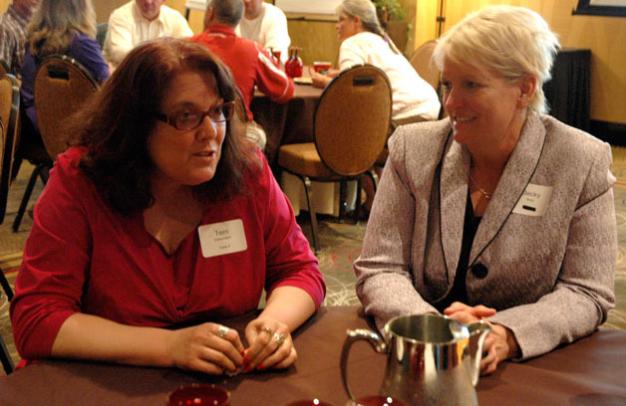By Frances Moore Lappé and Anna Lappé, Huffington Post
“This statement is supported by 81 Councillors of the World Future Council, a network of global luminaries who “form a voice for the rights of future generations,” and/or Laureates of the Right Livelihood Award, often called the Alternative Nobel. Supporters’ names appear below.”
In honoring the seed biotechnology industry, this year’s World Food Prize – to many, the most prestigious prize in food and agriculture — betrays the award’s own mandate to emphasize ”the importance of a nutritious and sustainable food supply for all people.”
The 2013 World Food Prize has gone to three chemical company executives, including Monsanto executive vice president and chief technology officer,Robert Fraley, responsible for development of genetically modified organisms (GMOs). Yet, GMO seeds have not been designed to meet the Prize’s mandate and function in ways that actually impede progress toward the stated goals of the World Food Prize.
Almost twenty years after commercialization of the first GMO seeds, by far the most widely used are not engineered to enhance nutrient content, but to produce a specific pesticide or to resist a proprietary herbicide, or a combination of these traits. Even in reducing weeds, the technology is failing, for it has led to herbicide-resistant “super weeds” now appearing on nearly half of American farms.
GMO seeds undermine sustainability in other ways as well.
While profitable to the few companies producing them, GMO seeds reinforce a model of farming that undermines sustainability of cash-poor farmers, who make up most of the world’s hungry. GMO seeds continue farmers’ dependency on purchased seed and chemical inputs. The most dramatic impact of such dependency is in India, where 270,000 farmers, many trapped in debt for buying seeds and chemicals, committed suicide between 1995 and 2012.
GMOs also threaten sustainability because they continue agriculture’s dependence on diminishing and damaging fossil fuels and mined minerals, as well as a wasteful use of water.
This award not only communicates a false connection between GMOs and solutions to hunger and agricultural degradation, but it also diverts attention from truly “nutritious and sustainable” agroecological approaches already proving effective, especially in the face of extreme weather. The Rodale Institute, for example, found in its 30-year study, that organic methods used 45 percent less energy and produced 40 percent less greenhouse gases and outperformed chemical farming during drought years by as much as 31 percent.
Further evidence from around the world is showing how ecological methods dramatically enhance productivity, improve nutritional content of crops, and benefit soil health, all without leaving farmers dependent on ever-more expensive inputs. The United Nations, through its Office of the Special Rapporteur on the Right to Food, has documented ecological agriculture’s potential in hungry regions to double food production in one decade. Chaired by former World Food Prize awardee Dr. Hans Herren, the 2008International Assessment of Agricultural Knowledge, Science and Technology for Development (IAASTD) report, developed by 400 experts and endorsed by 59 governments, calls for redirection of agricultural development toward such sustainable practices. Agroecology and food sovereignty are emerging solutions shaped and chosen by scientists and citizens worldwide.
Note that the World Food Prize mandate is also to recognize contributors to food “for all people,” but GMO seeds make this goal harder to reach. Most GM crops are used for feed for livestock, processed food, or fuel — products not accessible to hungry people. Moreover, the planet already produces more than enough food for all, and 40 percent more per person than in 1970; yet today 870 million people, still suffer from extreme, long-term undernourishment because they lack power to access adequate food. Developed and controlled by a handful of companies, genetically engineered seeds further the concentration of power and the extreme inequality at the root of this crisis of food inaccessibility. Monsanto, for example, controls 90 percent of the U.S. soybean crop and 80 percent of the country’s corn and cotton crops.
The choice of the 2013 World Food Prize is an affront to the growing international consensus on safe, ecological farming practices that have been scientifically proven to promote nutrition and sustainability. Many governments have rejected GMOs, and as many as two million citizens in 52 countries recently marched in opposition to GMOs and Monsanto. In living democracies, discounting this knowledge and these many voices is not acceptable.
The 81 signatories below are Councillors of the World Future Council and/or
Laureates of the Right Livelihood Award:29 COUNCILLORS OF THE WORLD FUTURE COUNCIL (An asterisk indicates the signer is also a Right Livelihood Award Laureate but listed only once.)
*Vandana Shiva, Founder, Research Foundation for Science, Technology and Ecology
*Frances Moore Lappé, Co-founder, Small Planet Institute
*Maude Barlow, National Chairperson of the Council of Canadians
*Dipal Barua, Founder and Chairman of the Bright Green Energy Foundation
*Hans-Peter Dürr, Nuclear physicist and philosopher
*Sulak Sivaraksa, Co-founder, International Network of Engaged Buddhists
*Ibrahim Abouleish, Founder of SEKEM
*Chico Whitaker, Co-founder, World Social Forum
*Manfred Max-Neef, Prof Dr. h.c. (mult.) Manfred Max-Neef, Director, Economics Institute, Universidad Austral de Chile
*Alyn Ware, Founder and international coordinator of the Network Parliamentarians for Nuclear Non-proliferation and Disarmament (PNND)
David Krieger, President, Nuclear Age Peace Foundation
Rama Mani, Vice Chair, Academic Council on the United Nations System
Alexander Likhotal, President, Green Cross International
Thais Corral, Co-founder, Women’s Environment and Development Organization
Pauline Tangiora, Maori elder, Rongomaiwahine Tribe
Anna Oposa, Co-Founder, Save Philippine Seas
Scilla Elworthy, Founder, Oxford Research Group, Founder, Peace Direct
Katiana Orluc, Director of Development/Strategic Affairs, Thyssen-Bornemisza, Art Contemporary (TBA21)
Riane Eisler, President, Centre for Partnership Studies
Ashok Khosla, Chairman, Centre for Development Alternatives
Hafsat Abiola, Founder and President of the Kudirat Initiative for Democracy (KIND)
Rafia Ghubash, President, Arab Network for Women, Science and Technology
Daryl Hannah, Actress and advocate for a sustainable world
Vithal Rajan, Founder, Trustee of Agriculture Man Ecology [AME], Foundation of India
Anuradha Mittal, Executive Director, The Oakland Institute
Herbert Girardet, Honorary Councillor, World Future Council
Ana María Cetto, Research professor of the Institute of Physics and lecturer at the Faculty of Sciences, Universidad Nacional Autónoma de México
Nicholas Dunlop, Secretary-General, Climate Parliament
Motoyuki Suzuki, Chairman, Central Environmental Council of Japan
52 ADDITIONAL RIGHT LIVELIHOOD AWARD LAUREATES
Alice Tepper Marlin, President & Founder, Social Accountability International, USA (RLA 1990)
Alla Yaroshinskaya, Russia (RLA 1992)
Andras Biro, Hungarian Foundation for Self-Reliance, Hungary (RLA 1995)
Angie Zelter, Trident Ploughshares, United Kingdom (RLA 2001)
Annelies Allain, International Baby Food Action Network, Malaysia (RLA 1998)
Anwar Fazal, Director, Right Livelihood College, Malaysia (RLA 1982)
Augusto Juncal, Movimento dos Trabalhadores Rurais sem Terra (MST), Brazil (RLA 1991)
Bianca Jagger, Founder and Chair, Bianca Jagger Human Rights Foundation, Nicaragua/UK (RLA 2004)
Birsel Lemke, Turkey (RLA 2000)
Daniel Ellsberg, USA (RLA 2006)
David Suzuki, Canada (RLA 2009)
Erik Dammann, Future in Our Hands, Norway (RLA 1982)
Bishop Erwin Kräutler, Brazil (RLA 2010)
Evaristo Nugkuag Ikanan, Instituto para el Buen Vivir, Peru (RLA 1986)
Felicia Langer, Israel/Germany (RLA 1990)
Fernando Funes-Aguilar, Grupo de Agricultura Orgánica, Cuba (RLA 1999)
Fernando Rendón, Co-Founder and Director, International Poetry Festival of Medellín, Colombia (RLA 2006)
GRAIN, International (RLA 2011)
Hanumappa Sudarshan, Karuna Trust & VGKK, India (RLA 1994)
Helen Mack Chang, Fundación Myrna Mack, Guatemala (RLA 1992)
Helena Norberg-Hodge, Founder and Director, International Society for Ecology & Culture, UK (RLA 1986)
Hunter Lovins, Natural Capitalism Solutions, USA (RLA 1983)
Ina May Gaskin, USA (RLA 2011)
Irene Fernandez, Tenaganita, Malaysia (RLA 2005)
Janos Vargha, Hungary (RLA 1985)
Prof. Dr. Johan Galtung, Norway (RLA 1987)
Juan Pablo Orrego, President, Ecosistemas, Chile (RLA 1998)
Katarina Kruhonja, Center for Peace, Nonviolence and Human Rights-Osijek, Croatia (RLA 1998)
Martín von Hildebrand, Founder and Director, Fundación GAIA Amazonas, Colombia (RLA 1999)
Melaku Worede, Ethiopia (RLA 1989)
Prof. Michael Succow, Founder, Michael Succow Foundation for Nature Conservation, Germany, (RLA 1997)
Mike Cooley, UK (RLA 1981)
SM Mohamed Idris, Sahabat Alam Malaysia-Sarawak, Malaysia (RLA 1988)
Monika Hauser, Founder, Medica Mondiale, Germany (RLA 2008)
Nicanor Perlas, Center for Alternative Development Initiatives, Philippines (RLA 2003)
Nnimmo Bassey, Health of Mother Earth Foundation, Nigeria (RLA 2010)
Pat Mooney, ETC Group, Canada (RLA 1985)
Raúl A. Montenegro, President, Fundación para la defensa del ambiente, Argentina (RLA 2004)
Ruchama Marton, Founder and President, Physicians for Human Rights, Israel (RLA 2010)
Shrikrishna Upadhyay, Executive Chairman, Support Activities for Poor Producers of Nepal, Nepal (RLA 2010)
Sima Samar, Chairperson, Afghanistan Independent Human Rights Commission, Afghanistan (RLA 2012)
Stephen Gaskin, PLENTY International, USA (RLA 1980)
Suciwati, widow of Munir, Indonesia (RLA 2000)
Swami Agnivesh, India (RLA 2004)
Tapio Mattlar, Kylätoiminta / The Finnish Village Action Movement, Finland (RLA 1992)
Tony Clarke, Executive Director, Polaris Institute, Canada (RLA 2005)
Uri Avnery, Founder, Gush Shalom, Israel (RLA 2001)
Wes Jackson, Founder and President, The Land Institute, USA (RLA 2000)
Zafrullah Chowdhury, Gonoshasthaya Kendra, Bangladesh (RLA 1992)
Percy and Louise Schmeiser (RLA 2007)
Jacqueline Moudeina (2011)













